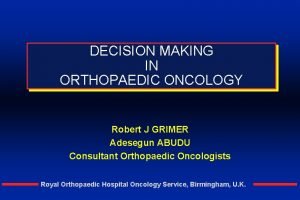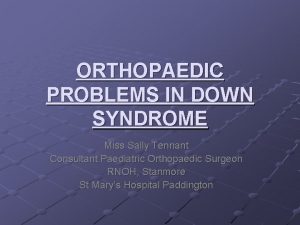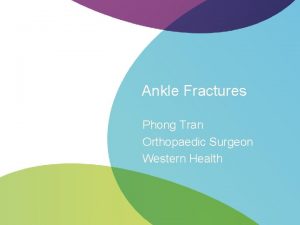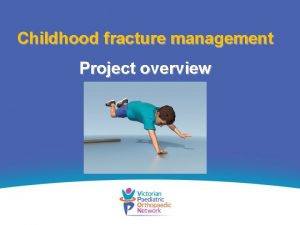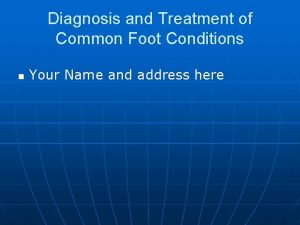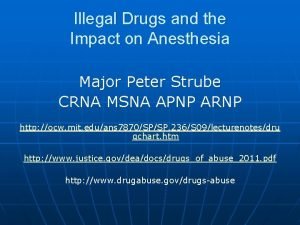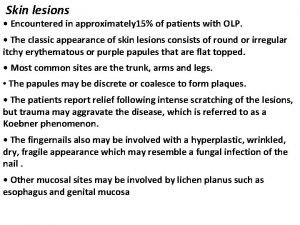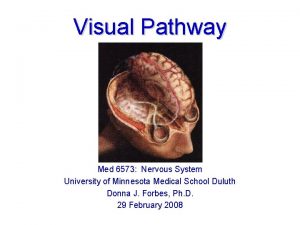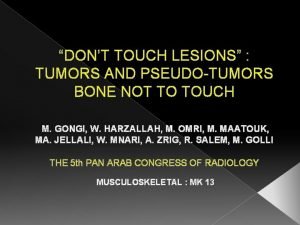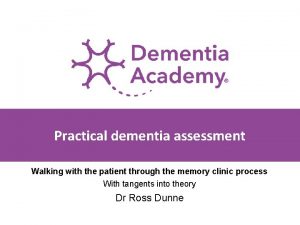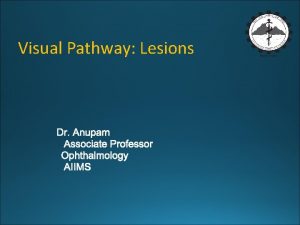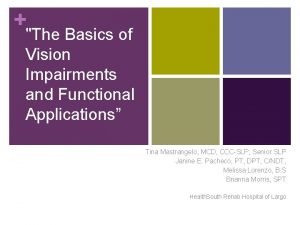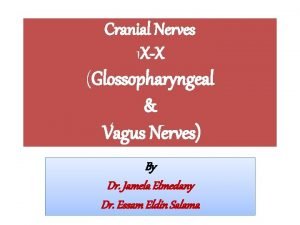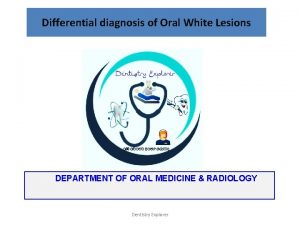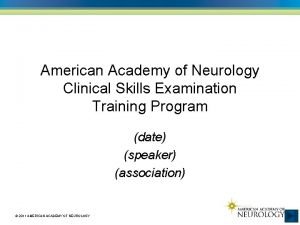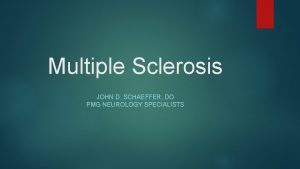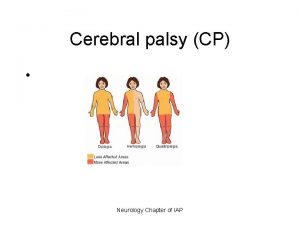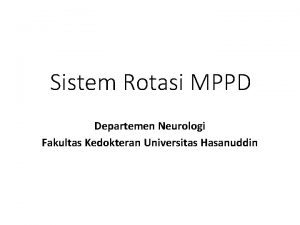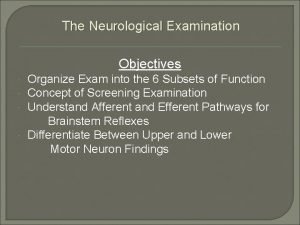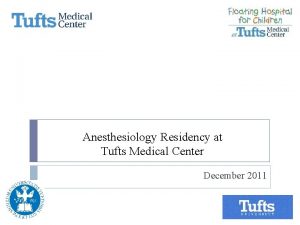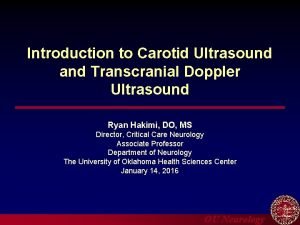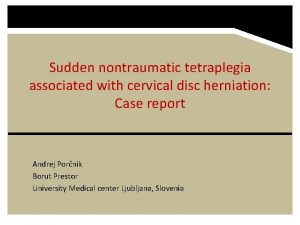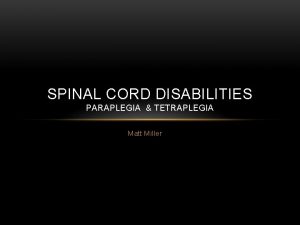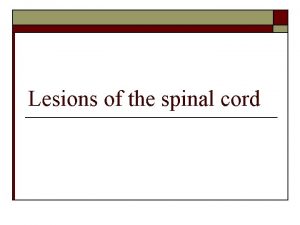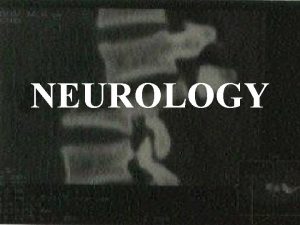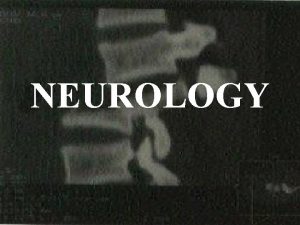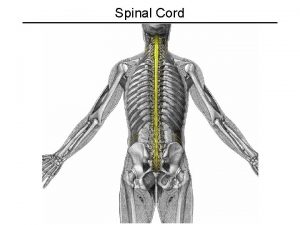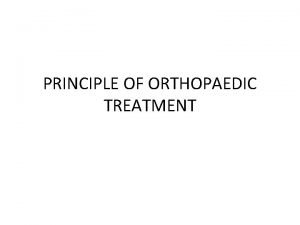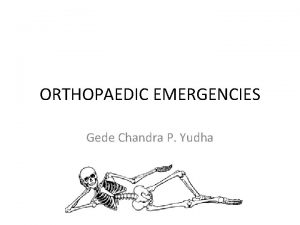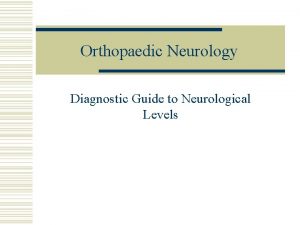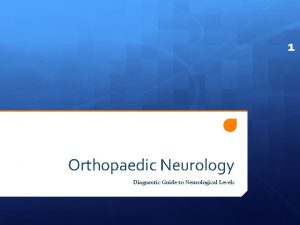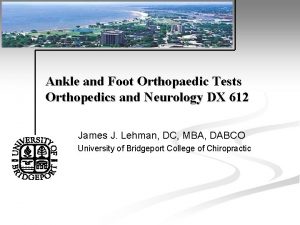Orthopaedic Neurology Cervical Cord Lesions Tetraplegia Stanley Hoppenfeld
























































- Slides: 56

Orthopaedic Neurology Cervical Cord Lesions: Tetraplegia Stanley Hoppenfeld, MD James J. Lehman, DC, MBA, DABCO DX 612 Orthopedics and Neurology University of Bridgeport College of Chiropractic

Tetraplegia or Quadriplegia n Tetraplegia or quadriplegia as it is more commonly known, means paralysis involving all four extremities.








Hoffmann’s Pathological Reflex

Jefferson’s “Bursting” Fracture


Hangman’s Fracture of C 2


Odontoid Fracture of C 2


Cervical Compression Fracture Hyperflexion Injury of the Cervical Spine









Activities of Daily Living Respiration n n C 3 or higher is incompatible with life and would require permanent ventilation C 4 -5 produces respiratory insufficiency and increases risk with an upper respiratory infection

Activities of Daily Living Wheelchair n n C 6 and below permits manipulation of a wheelchair C 6 presents transfer problems due to lack of innervation of the triceps

Activities of Daily Living Crutches n Complete cord lesions at C 8 and above prevent use of crutches due to loss of grip strength


Spinal Cord Lesions Below T 1 Including the Cauda Equina n Paraplegia is the complete or partial paralysis of the lower extremities and lower portion of the body.


Sensory Evaluation n Sensory evaluation is easier than the motor evaluation

Motor Evaluation n Motor testing of the intercostal muscles involves observation of the respiratory activity

Motor Evaluation n Abdominal and paravertebral muscles innervated by T 7 – T 12 (L 1) Half sit-up tests are not performed during acute stage Beevor’s Sign

L 1 Neurologic Level L 1 Intact n n n Some hip flexion but complete paralysis of lower extremities No sensation inferior to L 1 sensory band Initially LE DTR’s are absent When spinal shock wears off, the reflexes become exaggerated Loss of bowel and bladder function

L 2 Neurologic Level L 2 Intact n n Partial function of Iliopsoas and adductors No sensation below L 2 sensory band Minimal patellar reflex possible No voluntary control of bowel and bladder

L 3 Neurologic Level L 3 Intact n n n Partial function of quadriceps and adductors Full strength of Iliopsoas Sensation is normal to level of knee Decreased patellar and absent Achilles No bowel and bladder control

L 4 Neurologic Level L 4 Intact n n Iliopsoas, adductors, and quadriceps motor WNL Tibialis inverts and dorsiflexes foot Sensory loss to L 5 and S 1, 2, 3, 4 No voluntary control of bowel and bladder function

L 5 Neurologic Level L 5 Intact n n Gluteus maximus does not function with hip flexion deformity Partial function of gluteus medius Knee flexors function partially with medial hamstring but not the lateral hamstrings Dorsiflexion deformity of foot due to plantar flexors and evertors absent

L 5 Neurologic Level L 5 Intact n n n Lower extremities have normal sensation except at lateral side and plantar surface of foot Medial hamstring and patellar DTR WNL but achilles is zero + No control of bowel and bladder function

S 1 Neurologic Level S 1 Intact n n n Slight gluteus maximus weakness Weakness in soleus and gastrocnemius Clawing of toes due to weakness of intrinsic muscles

S 1 Neurologic Level S 1 Intact n n Sensation in lower extremities WNL Perianal anesthesia DTR for LE are 2+ No bowel or bladder function

Pathologic Reflex Babinski Sign is Present

Pathologic Reflex Oppenheim’s Sign is Present

Normal Superficial Reflex Cremasteric Reflex











 Spacisity
Spacisity Professor abudu royal orthopaedic hospital
Professor abudu royal orthopaedic hospital Sally tennant orthopaedic
Sally tennant orthopaedic Stephen brennan bon secours
Stephen brennan bon secours Phong tran orthopaedic surgeon
Phong tran orthopaedic surgeon Peter worlock
Peter worlock Vbpm orthopaedic
Vbpm orthopaedic Fracture
Fracture Charcot joint
Charcot joint Orthopaedic treatment south east london
Orthopaedic treatment south east london National orthopaedic hospital cappagh
National orthopaedic hospital cappagh Oral pathology
Oral pathology Olneys lesions
Olneys lesions Periradicular tissue definition
Periradicular tissue definition Site:slidetodoc.com
Site:slidetodoc.com Classification of white lesions of oral cavity
Classification of white lesions of oral cavity Describing skin lesions
Describing skin lesions Pr��ca it projektov�� mana����r
Pr��ca it projektov�� mana����r Red nucleus function
Red nucleus function Eye lesions
Eye lesions Lésions
Lésions Don't touch lesions
Don't touch lesions Premalignant lesions of esophagus
Premalignant lesions of esophagus Scattered white matter lesions
Scattered white matter lesions Gj mount classification of caries
Gj mount classification of caries Optic tract lesions
Optic tract lesions Vesiculobullous lesions
Vesiculobullous lesions Convergence insufficiency athens
Convergence insufficiency athens Lesion to vagus nerve
Lesion to vagus nerve Dermatology morphology
Dermatology morphology Daughter mother grandmother pancreatic lesions
Daughter mother grandmother pancreatic lesions Amiante
Amiante Pyramidal vs extrapyramidal lesions
Pyramidal vs extrapyramidal lesions Site:slidetodoc.com
Site:slidetodoc.com Miqtu
Miqtu Nin bajaj
Nin bajaj Nex exam neurology
Nex exam neurology Mayzent fdo
Mayzent fdo Cerebral palsy iap
Cerebral palsy iap Uf neurology residency
Uf neurology residency Umass pharmacy residency
Umass pharmacy residency Nbme shelf exam percentiles 2020
Nbme shelf exam percentiles 2020 The walton centre for neurology and neurosurgery
The walton centre for neurology and neurosurgery Neurology near loomis
Neurology near loomis Joseph berger md neurology
Joseph berger md neurology Mary bridge neurology
Mary bridge neurology Midwest neurology
Midwest neurology Midwest neurology
Midwest neurology Rrerl
Rrerl Mppd unhas
Mppd unhas Neurology strength scale
Neurology strength scale Tufts anesthesiology residents
Tufts anesthesiology residents Contrallateral
Contrallateral Neurology sonography
Neurology sonography Neurology
Neurology Nlff neurology
Nlff neurology Dr raeburn forbes
Dr raeburn forbes

